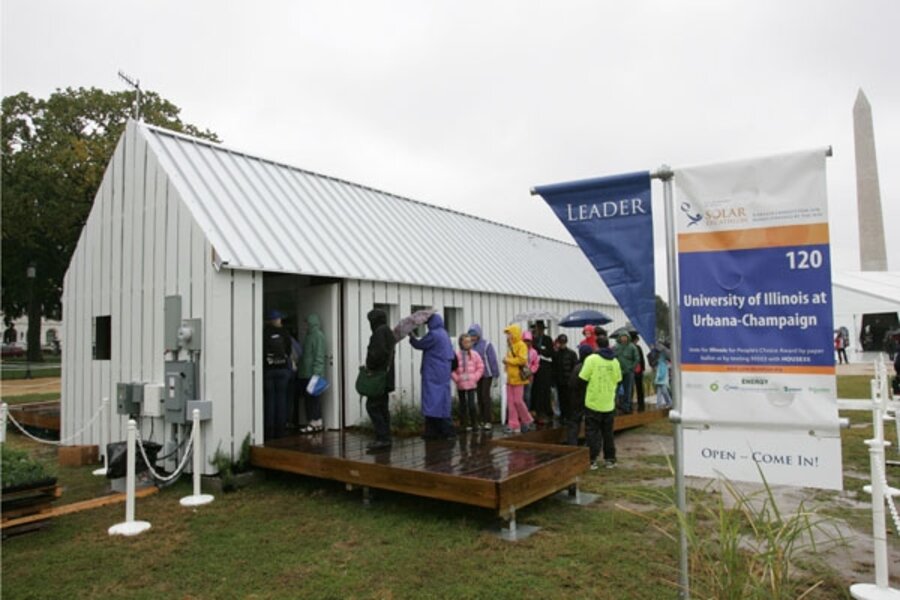50 million footprints play havoc with the grass on the Washington Mall
Loading...
| Washington
Fall brings the Washington Mall to its annual low point. This is when many of the turf panels have been beaten back by so many feet over the previous six months that calling it turf is an act of generosity. Some of the rectangles of lawn are no more than a blend of bare soil and weeds. "Soil" might also be a misnomer.
"The maximum (soil) density we have measured was about equivalent to cinder block," said Robert DeFeo, a horticulturist with the Mall's stewards, the National Park Service.
Each fall, the pattern of rejuvenation repeats itself in an exercise that calls to mind Samuel Johnson's view of a second marriage: the triumph of hope over experience.
The landscape crews might add a top dressing of compost, rough up the ground with an aerating machine, and then sow the seed in slits.
By April, when the new grass looks green and perky, the fences come down, and then it is flattened by ballplayers, tourists, protesters, joggers, and all the rest.
This is America's most beloved civic space, and it is meant to be used to commemorate, celebrate, and recreate, but as increasing numbers do a number on the greensward, the suffering is evident, and the solution to it less so.
"If you had 25 million people walking through your front yard — that's 50 million footprints, assuming everybody has two legs — it's reasonable to expect it would look the same way," said Bill Line, a Park Service spokesman.
It's not just feet, though. It's tents and other structures for special events. (Twenty houses, plus tents and trailers, were placed on the Mall in October for the Solar Decathlon.) One year, during a military display, there were tanks.
The Mall is the most visited and trampled park in the nation, particularly its core between Third and 14th streets. This 70-acre axis is nearly a mile long and defined by eight grass panels bounded on each side by corresponding lawns shaded with hundreds of American elm trees.
The Park Service fences off the vulnerable elms for several months a year, but the central panels take the heaviest beating. The idea is that the turf can be repaired a lot easier than stressed old shade trees.
Apart from the damage to the blades of grass, sufficient injury to a clump will kill off its regenerating crown. The biggest problem is with soil compaction, which presses the top few inches into a block that robs the roots of the air and moisture they need.
Compacted soil drains poorly and causes waterlogging that can rot the plants. Of course, putting a tent or flooring over the grass for a few weeks will take away its food source, sunlight.
After years of decline and underfunding — the backlog of repair projects on the Mall is estimated to cost as much as $400 million — people are waking to the need to fix it.
The Park Service is in the midst of developing a long-term plan whose options include such wholesale infrastructure improvements as more paved areas, more amenities, capturing rainwater for irrigation (most of the Mall's turf irrigation system is bust), and seeking to manage and place special events to minimize damage to the lawns. Line stressed, however, that "First Amendment demonstrations are going to be allowed to go anywhere."
In one of the proposals under consideration, the Park Service would set up a system of "intense post-event recovery procedures ... and smaller areas would be set aside more frequently for rehabilitation."
Options include renovating the lawns by excavating the silt and putting in engineered soils and irrigation systems that would allow the turf to better handle all those feet.
The Mall is benefiting from money from the federal economic stimulus program: $30.5 million to repair the stagnant reflecting pool in front of the Lincoln Memorial, $18 million to fix parts of the Tidal Basin sea wall that are sinking, and $10 million to restore the D.C. War Memorial.
A plan to set aside $200 million for resodding the Mall was eliminated from the stimulus bill after some members of Congress objected. That "really irked everyone," said Angela Dye, a member of an American Society of Landscape Architects blue ribbon panel on the Mall.
"Grass. I call it the Rodney Dangerfield of the plant world," said Tukey. "It gets no respect."
Editor’s note: For more on gardening, see the Monitor’s main gardening page, which offers articles on many gardening topics. Also, check out our blog archive and our RSS feed. You may want to visit Gardening With the Monitor on Flickr. Take part in the discussions and get answers to your gardening questions. If you join the group (it’s free), you can upload your garden photos and enter our contests.





